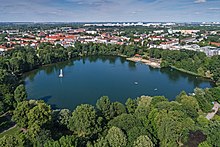Dead lake
A Toteissee ( Toteis-See ) is a lake that arises in formerly glaciated areas when the glacier retreats. The basin of the lake is formed by ice blocks that were previously separated from the main tongue of the glacier and slowly melt away later.
genesis
A dead lake is created when a glacier retreats. If an ice block separates from it, it is called a dead ice block . If more melt water flows off the glacier , this can accumulate sand and gravel around the ice block. This isolates the ice under the sediment material and thus melts more slowly. After the ice has melted completely, a cavity is created which, after the sediment material collapses above it, is called a dead ice hole or kettle. If groundwater now flows into the boiler, a dead lake is created. Dead ponds are mostly inflow and outflow. However, there are also lakes that have surface drainage.

The shape and size of dead ice depends on the dimensions of the existing block of dead ice and is very variable. Small dead ponds are only a few thousand to ten thousand square meters, while large dead ponds are several square kilometers in size. If the dead ice filled a glacial channel , the resulting lakes are mostly narrow and elongated. Dead ponds in tongue basins often have round shapes, but there are also lakes with a rather irregular shape.
The depths of the dead ponds are also very different and vary between 0 and several dozen meters. For example, the deepest lake in Brandenburg , the 60 m deep Stechlinsee , is a dead lake. In addition, the depth depends on the progressive backfilling of the lake basin with deposits, for example mudde . Some of the dead pits, especially the smaller and shallow ones, are completely silted up.
Occurrence
Dead ponds are a widespread phenomenon of newly glaciated areas ( young moraine landscape ). They occur where the conditions for the formation of dead ice were good. So you can find them more often in terminal moraine areas , on sand (gravel plains) and in glacial valleys .
Dead pits from the older Riss Ice Age or Saale Ice Age are almost all silted up today. However, based on the lake deposits that have been preserved to this day, it can be determined that they were once abundant.
List of dead ponds
|
|
||||||||||||||||||||||||||||||||||||||||||||||
See also
Web links
- Ice age. physik.wissenstexte.de





